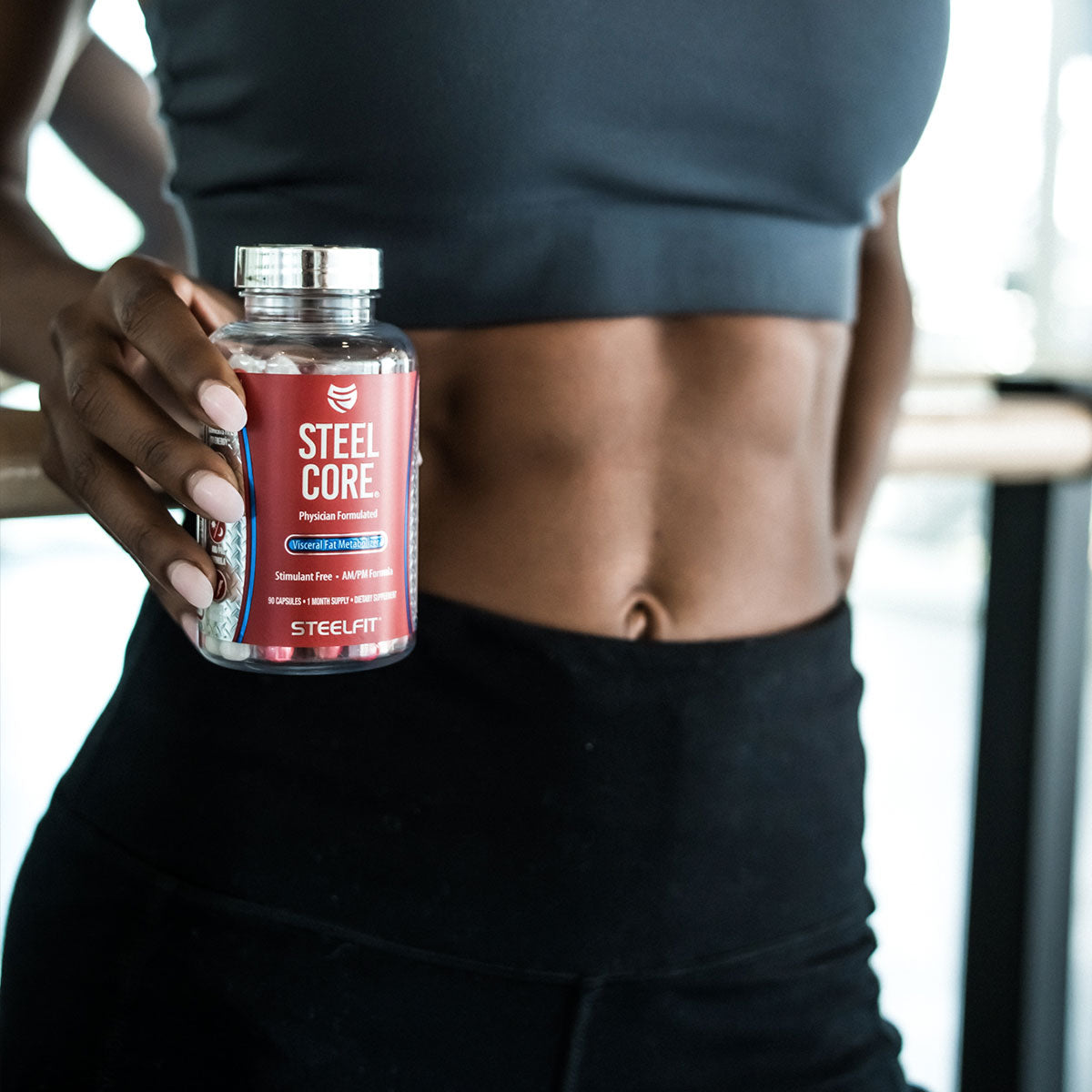If you want to know how many calories you should eat to build muscle or lose fat, you'll want to read this article.
“How many calories should I eat?”
This question is asked more often than you would believe, especially by those entering the fitness lifestyle for the first time.
The answer to that question is -- it depends.
Do you want to build muscle? Do you want to lose body fat? Or, do are you satisfied with your current physique and you would like to maintain your weight where it is.
Different goals require different calorie intakes. And, to further complicate the matter every person is different. Even if two people are roughly the same age, sex, height, and weight, and they have a similar amount of lean body mass, the could still have very different calorie needs.
You see there isn’t a one size fits all solution to the common question of “how many calories should I eat?”
But, despair not, as we’re going to show you in this article how to calculate the number of calories you need for your body based on your goals.
No matter if your goal is muscle gain, fat loss, body recomposition, or performance, the information in the article can help you achieve the results you want.
And, it all starts with a little something called TDEE.
What is TDEE?
Wondering what is TDEE? TDEE stands for Total Daily Energy Expenditure. It is the total number of calories you burn in a given day. Your TDEE is determined by four key factors:
- Basal Metabolic Rate
- Thermic Effect of Food
- Non-Exercise Activity Thermogenesis
- Thermic Effect of Activity (Exercise)
Basal Metabolic Rate (BMR)
Basal metabolic rate refers to the number of calories your body burns each day to keep you alive. BMR does not include physical activity, the process of digestion, or things like walking from one room to another.
Basically, BMR is the number of calories your body would expend in a 24 hour period if all you did was lay in bed all day long. This is the absolute bare minimum of calories it takes to ensure your survival.
Thermic Effect of Food (TEF)
When we eat food, our body must expend energy to digest the food we eat. This energy expenditure is referred to as the Thermic Effect of Food, and it involves breaking down the protein, carbohydrates, and fat you consume into the individual amino acids, sugars, and fatty acids that are then absorbed and used to by the body to carry out all of its processes including (but not limited to) building new tissue, synthesizing hormones, producing neurotransmitters, etc.
Research notes that the Thermic Effect of Food generally accounts for 10% of your total daily energy expenditure, but can be slightly higher or lower based on the exact macronutrient composition of your diet.<1>
For example, protein requires more energy to digest than carbohydrates or fat. So, if you’re eating a high protein diet, you will burn more calories, slightly, than if you were to eat the same number of calories, but with a significantly lower amount of protein.
Non-Exercise Activity Thermogenesis (NEAT)
Non-exercise Activity Thermogenesis (NEAT) constitutes the number of calories expended during daily movement that is not categorized as structured exercise. NEAT includes activities such as walking the dog, moving from one room to another, or taking the stairs to your office.
NEAT is highly variable from one person to another and can play a rather large or small role in your overall TDEE depending on how physically active your job or daily happenings are. For example, a waitress or construction worker will have a significantly greater NEAT than an office worker who sits at a desk for 8 hours of the day and spends 2 hours commuting to and from work.
Thermic Effect of Activity (TEA)
Thermic Effect of Activity is the number of calories burned as a result of exercise (i.e. steady-state cardio, resistance training, HIIT, sprints, CrossFit, etc.). Similar to NEAT, thermic effect of exercise is highly variable from one person to another or even from one day to another for the same person, as the intensity of training, length of the workout, and training frequency all impact your weekly thermic effect of activity.
Your TDEE is the sum of these four factors, so to put the above parameters into a math equation for simplicity sake, calculating TDEE looks a little something like this:
TDEE = BMR + TEF + NEAT + TEA
When you add all of these numbers together, you get an estimate of the number of calories you need on a daily basis to maintain your current weight.
Now, let’s take a look at how you can calculate your individual TDEE.
How to Calculate TDEE
Figuring out your total daily energy expenditure begins with calculating your BMR. The reason we’re starting with BMR is that it contributes the biggest portion of your TDEE.
Now, there are a lot of handy calculators readily available on the internet for calculating BMR as well as TDEE. But, the way to truly understand how those fancy calculators work is by understanding the equations powering them.
So, that’s exactly what we’re going to do.
Calculating Basal Metabolic Rate
Researchers have developed a number of models for calculating BMR, and one of the most popular ones is the Harris-Benedict Equation, which takes into account age, height, and weight.
Here’s a step-by-step guide to calculate your BMR using the Harris-Benedict Equation:
- Women BMR = 655 + (9.6 X weight in kg) + (1.8 x height in cm) – (4.7 x age in yrs)
- Men BMR = 66 + (13.7 X weight in kg) + (5 x height in cm) – (6.8 x age in yrs)
As an example, let’s take a 30-year-old male named John who is 6 feet tall and weighs 185 lbs.
So, John’s stats converting from imperial units to metric yields:
Age: 30
Height: 6’0” = 72 inches = 182.88cm (to convert inches to centimeters, multiply your height in inches by 2.54)
Weight: 185 lbs = 84.09kg (to convert pounds to kilograms, divide your weight in pounds by 2.2)
Using the Harris-Benedict Equation for men, and plugging the above numbers into the equation gives you:
BMR = 66 + (13.7 x 84.09) + (5 x 182.88) - (6.8 x 30)
BMR = 66 + 1152.03 + 914.4 - 204
BMR = 1928.43
So, as a bare minimum to sustain life and ensure longevity, our example male John would need to consume roughly ~1930 calories.
The next step in figuring out TDEE would be to calculate the thermic effect of food as well as the non-exercise and exercise factors. However, these calculations are extremely tedious and the equations to model the caloric expenditure each requires isn’t the most reliable.
Fortunately, you don’t have to spend hours performing more tedious calculations. You don’t even have to use a fitness monitor or rely on those erroneous “Calories Burned” readouts on cardio machines to figure out the rest of the components of your TDEE.
Researchers have determined a set of “activity multipliers, known as the Katch-McArdle multipliers.
To calculate your approximate TDEE, simply multiply these activity factors by your BMR:
- Sedentary (little to no exercise + work a desk job) = 1.2
- Lightly Active (light exercise 1-3 days / week) = 1.375
- Moderately Active (moderate exercise 3-5 days / week) = 1.55
- Very Active (heavy exercise 6-7 days / week) = 1.725
- Extremely Active (very heavy exercise, hard labor job, training 2x / day) = 1.9
Going back to our example guy John, let’s assume he trains 3 days per week following a high-frequency full body training program with no additional steady-state cardio or HIIT training during the week. This puts John in the “Moderately Active” category.
To calculate John’s approximate TDEE, multiply his BMR by 1.55. This gives us:
TDEE = 1.55 x BMR
TDEE = 1.55 x 1928.43
TDEE = 2989.07
So, our example guy John needs to consume about 2990 calories each day just to maintain his current weight.
Now, at this point, it’s important we stress that these equations and activity multipliers provide AN ESTIMATE for your daily calorie requirements. That is, your actual TDEE could be a little higher or lower than the number you calculate when you use the formula. But, it should be fairly close, and at the very least, it gives you a rough idea of where to start when figuring out a meal plan and setting macronutrient goals.
Speaking of goals, now let’s look at how you can use your TDEE to enhance your body composition whether it be for muscle gain or fat loss.
Manipulating TDEE for Muscle Gain and Fat Loss
So, how does knowing your TDEE help you gain muscle or lose fat?
While there’s endless debate in the fitness world about the “optimal” way to go about reshaping your body, this much is true:
- If you want to lose fat, you need to eat fewer calories than your TDEE. Doing so forces your body to draw energy from its fat stores to compensate for the calories you’re not consuming each day. Do this long enough and you will lose weight and body fat
- If you want to gain muscle mass, you need to eat more calories than your TDEE.To gain weight, you must be in a caloric surplus. Coupled with a rigorous training program following the principles of progressive overload, those extra calories will be put to building new muscle tissue.
Now, let’s see how to put this into practice
For Fat Loss
To lose fat, we typically recommend that using a caloric deficit of 20%. Once again using John as an example, if he wanted to cut fat, his caloric intake would be:
20% of TDEE = 0.20 x 2990 = 598
Daily calorie intake for weight loss: 2990 - 598 = 2,392 calories
At a 598 daily calorie deficit, John would lose a little over 1 pound per week, as 1 pound of fat equals approximately 3500 calories.
Now that we have the caloric intake needed for fat loss, we need to set John’s macros.
Protein: 1 gram per pound of bodyweight
Fat: 0.3 - 0.5 grams per pound of bodyweight
Carbohydrates: The number of calories remaining after protein and fat requirements are met.
Going back to our example guy John his daily macros, while eating at a 20% caloric deficit, would be:
- Protein: 1g / lb x 185 lbs = 185g (Calories = 185g x 4 calories / g of protein = 740)
- Fat:5g / lb x 185 lbs = 92.5g (Calories = 92.5g x 9 calories / g of fat = 832.5)Note: Fat can range from 0.3-0.5 grams per pound of bodyweight. Adjust up or down based on your own dietary preferences. If you enjoy eating a higher fat diet, use the 0.5g/lb multiplier, and if you enjoy a higher carb, lower fat diet use 0.3g/lb.
- Carbs are determined by subtracting your protein and fat calories from the daily calorie total, then dividing by 4 to get the number of carbs you eat per day (as each gram of carbohydrate contains 4 calories). Calories left after removing protein and fat Calories = 2,392 - 740 - 832.5 Calories alloted for carbohydrate = 819.5 (which we’ll round up to 820 for simplicity)Now, divide 820 by 4 to get the total grams of carbohydrates John needs to consume each day:820 / 4 = 205g Carbohydrates
Therefore, John would consume the following macronutrient profile to lose fat while preserving lean muscle mass:
Protein: 185g
Fats: 92.5g
Carbohydrates: 205g
Eating at this calorie level should have John losing a little over one pound per week. Now, remember, the TDEE and BMR calculations are estimates. If you find, after performing your own calculations, that you’re not losing weight, then remove another 100 calories from your daily calorie intake and assess progress over the next 2 weeks.
If however, you find yourself losing more than 2 pounds per week, add 100 calories back into your diet. While it might seem great, losing too much weight too fast typically results in muscle loss as well, which is not what you want in the least.
Now, let’s look at how to manipulate TDEE for gaining muscle.
Muscle Gain
Gaining weight, and preferably muscle, requires consuming more calories than your body expends on a daily basis. When combined with a structured resistance training program, a caloric surplus provides the essential nutrients needed to optimize performance and build muscle.
For the longest time, it was preached that in order to get big, you had to eat big too. But, as sports nutrition has developed over the years, lifters and researchers alike have learned that the surplus needed to build lean muscle tissue isn’t a huge as we were once led to believe.
Simply put, the body can synthesize a finite amount of muscle tissue at any given time. That means that eating substantially more than what is required to build new muscle just leads to excess fat gain. Therefore, the trick to minimizing fat gain while trying to build muscle is to use a moderate calorie surplus, giving your body just enough to grow bigger, stronger, and faster, without getting fatter. This approach to muscle gain is known today as lean bulking.
To build muscle and limit fat gain, you need to consume roughly 200-300 calories above your TDEE.
So, using our example guy John again, whose TDEE was 2990. He would need to consume between 3190-3290 calories consistently day in and day out to gain muscle.
When undertaking a mass gaining phase, most coaches recommend that you get your surplus calories from carbohydrates, as they fuel performance in training, enhance recovery, and prevent muscle breakdown. They also help raise insulin levels, which is great for shuttling nutrients into your muscles cells needed for repair and growth.
But, if you find you enjoy more fat in your diet, you can feel free to get the extra 200-300 calories from fat or any mix of protein, carbohydrates, and fat. There’s no set in stone ideal ratio for gaining muscle once your minimums are taken care of.
Now, if you find that you are not gaining at least 0.25 lb/week, add another 100 calories to the daily caloric intake. If, however, you’re gaining over 1 lb per week, reduce your calorie intake by 100-200 calories. Gaining too much weight too fast usually means that you’re gaining a good bit of fat in addition to muscle, which means you’re eventually going to have to spend more time cutting later on in your fitness journey.
Takeaway
Total daily energy expenditure is the number of calories your body burns in a given day taking everything into account from sleep to digestion to exercise. TDEE calculators offer a way for you to figure out a close approximation to the actual number of calories you burn in a day, which you can then use to structure a diet for building muscle or burning fat.
Through proper manipulation and application of your TDEE, you have the power to reshape your body in your own ideal image and never ever have to settle for another cookie cutter meal plan or diet protocol. When knowing how many calories you need to eat for muscle gain or fat loss, you can eat the foods you enjoy while adhering to the calorie and macronutrient goals you set.
The saying goes “with knowledge comes power.” Well, we’ve now given you the knowledge and power to craft your ideal physique. It’s up to you to do the rest!
References
- Tappy, L. (1996). Thermic effect of food and sympathetic nervous system activity in humans. Reproduction, Nutrition, Development, 36(4), 391–397. http://www.ncbi.nlm.nih.gov/pubmed/8878356/




















